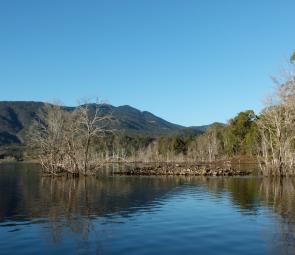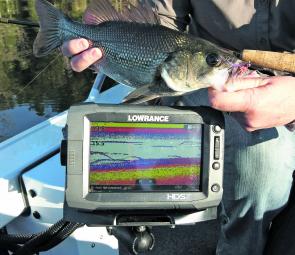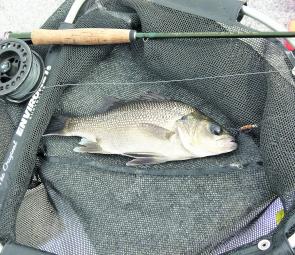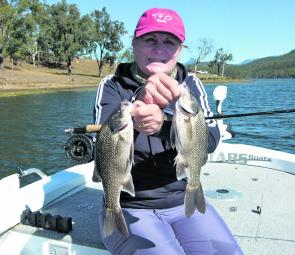Maroon Dam is quite a special fly fishing destination. What the resident bass lack in size they more than make up for in numbers!
A great fan of this mountain fringed impoundment, I have been pushing the boat off the trailer at Maroon’s ramp quite a bit through the cooler months and it seems to me that, lately, things have. The bass are still there and quite fly catchable but I’ve noticed the need for different tactics compared to the same time frame last year.
Firstly, there has been an alteration to Maroon’s water level, which appears to be down by almost 2m from last September’s height. Surprisingly, instead of Maroon’s renowned weed beds being more noticeable as the result of the reduced water level, the opposite has occurred. There’s been a marked reduction in weed growth around all of the dam’s shoreline which means that a lot of the thick weed beds that were cresting the surface last September have declined to the point where they are now some distance under the water.
One result of these changes will be noticed in the surface fishery, something that has been an important feature of this impoundment. With the reduction in surface weed systems the fish don’t come into the shoreline weed areas as much. Being on the water at the first hint of light or staying until dusk and mooching quietly over towards the shore for a fish (in an area right out of any breeze) can still be worthwhile, but there just doesn’t seem to be the numbers of fish wanting to play. So, to maximise success, it’s more important than ever that a stealthy, quiet approach be made to a chosen area when doing some surface fishing. Get that electric motor into use!
That said, I would still, at dawn or dusk, have a 5-6wt fly outfit rigged with a floating fly line and a dry fly such as a size 6 Muddler Minnow, Gartside or Grabhams Curgler on a 4kg tippet and give it a decent try. Sitting quietly in close proximity to a weed bed and gently landing the fly on the water adjacent to the weed growth, or to any place where it breaks the surface, is the key to success.
Also, with dry flies, do remember that less is more. Maroon bass have seen plenty of flies and they don’t seem to want to attack an offering moving too energetically or with too many ripples. Also, if a tiny retrieve is made it’s smart tactics to feed some slack back into the system as the fly slows so a fish can take the fly without feeling any tension from the leader. That same system works on anything from barra to bass, of course.
I do believe that success can also come down to the particular morning. If it’s warm, cloudy and fairly windless then things are in the angler’s favour. A clear, breezy morning with some chill about it might well see the fish shunning the shallows.
Another tactic that I’ve seen successfully used around the weed beds (again, in time of low light) will involve the use of an intermediate sink line in lieu of a floating one. The method of fishing can best be described as ‘cast and strip’. On the tippet there’s a size 6 wet fly such as an olive or black Leech pattern, a Vampire in red and black or bronze and black (this latter colour combo works well in Maroon) or a simple Clouser in red and black colours. The technique again involves staying close to the weed bed and casting the fly some distance over the top of the submerged weeds. Allowing a couple of seconds for it to sink a bit then commencing a fairly brisk, twitchy, retrieve should see a bass nail it before it moves too far. If the fly is ticking the weed occasionally that’s fine; so long as a bit of weed doesn’t stick the fly will still do it’s job.
Be advised though, that when fishing in the early morning as the sun comes onto the weed bed it’s usually time to move to deeper water and try the next trick up the sleeve.
This last method is regarded by many as the ‘usual’ method of fly fishing for bass. Yet because the sounder will often detect Maroon’s bass schooled up in around, or less than, 6m of water once they depart the shallows the fly line does not need to be an especially fast sink one. An intermediate sink rate line can work fine, the clue is to allow a bit longer for it to get down to where the fish seem to be on the job. A reference to the sink rate on the box the line came in will help.
A point worth noting - in the last few months in Maroon Dam I have noted a lot of bass sitting right on the bottom in water from around 6-10m in depth in lieu of an expected situation where they are distributed from the bottom up to around mid water depth and showing obvious signs of moving around feeding. When the bass are sitting right on the bottom, an angler could be forgiven for thinking they are sedentary but this is often not the case. Once the fly (the same one used in the cast-and-strip over the weed beds) is among them, a fish will usually grab it.
The thing to remember is that if the sounder is showing around a half dozen or more fish sitting right on the bottom it’s a virtual certainty that they will have a lot of mates in the immediate area. And in many cases they are catchable, it just comes down to working out a good drift, getting the entire fly line out of the line guides (nothing wrong with using the electric motor here) allowing time for the fly and line to get right to the bottom and then commencing the slow strip and draw process.
Using this method on the southern end of the dam out from the Camp Lakefire water intake I have scored some good catches. Fish to 40cm are scarce, larger ones even more so, but the Maroon bass are usually plentiful. Another excellent area to look for fish sitting on the bottom is the 6m area east of the ski club buildings.
Maroon may be changing but the fish are still there. Adapt your tactics and make the most of this great waterway.
Reads: 4343
Lowered water level or not, Maroon Dam is still a very pretty place to enjoy some fly fishing.

The sounder tells the story of a lot of fish sitting right on the bottom. Note the small Vampire pattern the fish was taken on.

A bronze and black Vampire was too much for this Maroon Dam bass to ignore.

This pair of Maroon bass taken by Denise Kampe are fairly representative of the fish the fly angler will enjoy catching this year.




